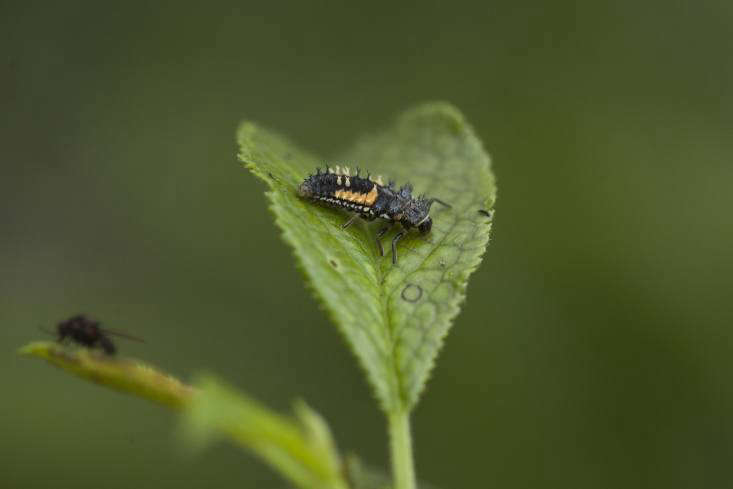Ladybugs feed on thousands of aphids in their lifetime, even laying their eggs on the underside of leaves that are under attack. This way, the larvae that hatch a week later, do not have to look for food. Ladybug parents, grandparents, great-grandparents and great-great grandparents prefer aphids above all else, so it is worth identifying ladybug children, which look like a different species altogether.
Photography by Jim Powell, for Gardenista.

In the autumn it is becoming increasingly common in temperate regions to find ladybugs inside the house. It is important to direct them outdoors at the earliest opportunity, as they send out pheranomes telling their chums that they’ve found a great place to spend the winter. Even if they survive attempts at eradication, they would probably die of dehydration. The best policy is to try to sweep them away as early as possible.
This kind of behavior is associated with the imported super-predator, Harmonia axyridis, the harlequin ladybird beetle. Native ladybugs (so-called in the US, although they are not true bugs but beetles) overwinter in leaf litter and log piles.

Although Harlequins were purposefully imported to the United States and continental Europe from East Asia as a form of biological pest control, their voracious appetite for aphids has proved too much of a good thing. When supplies run low, they turn to the eggs and larvae of butterflies, moths, lacewings, and, unfortunately, ladybugs (though not their close relations apparently).

Just as there is no way of deterring harlequins from choosing your sunny interior, it isn’t possible to target the invaders, in a bid to save the natives. Although harlequins are larger, there are so many variants that it can be difficult to tell them apart. The most common American native is the convergent lady beetle (Hippodamia convergens) while the most common European native is the 7-spot ladybird (Coccinella septempunctata).

Conversely, if a gang of ladybugs, harlequin or otherwise, chooses your garden to breed in, then it is a piece of good luck, especially if you grow roses, soft fruit, sweet peas, lilies, etc. After the crocodile-like larvae are identified, it is easy to divert them as well as the adult beetles toward aphid colonies if they have not found them already. Combined with finger-squashing, they are an effective system. To keep the food chain moving efficiently it is a good idea to leave some weeds alone, such as sow thistle and nettles, as they provide early food for aphids, giving early ladybugs something to eat.


While native ladybugs produce one generation in a year, their competitors produce up to five, if the warm season is long enough. This is why, during an average summer even in the UK, it is possible for a particular tree or south-facing climber to be inundated with ladybugs, at every stage. They may be harlequins but at least ladybugs are not themselves in short supply. Just make sure that they have plenty to eat, so that they don’t turn on each other.

N.B.: More ways to make your garden hospitable to beneficial insects:
- Required Reading: The Wildlife Gardener.
- 10 Easy Pieces: Bee Houses.
- Landscape Ideas: What to Plant for Pollinators? Choose Milkweed.









Have a Question or Comment About This Post?
Join the conversation